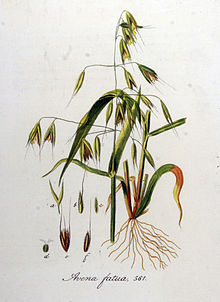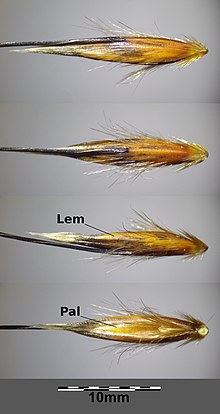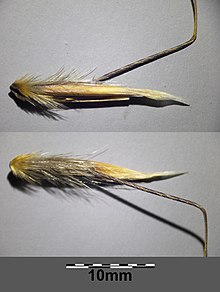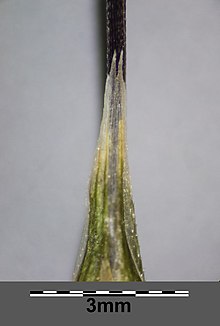Flight oats
| Flight oats | ||||||||||||
|---|---|---|---|---|---|---|---|---|---|---|---|---|

Flight oats ( Avena fatua ) |
||||||||||||
| Systematics | ||||||||||||
|
||||||||||||
| Scientific name | ||||||||||||
| Avena fatua | ||||||||||||
| L. |
The flying oat ( Avena fatua ), also called wind oat, is a species of the oat genus ( Avena ) within the sweet grass family (Poaceae). It can be a problematic field weed , especially in seed and oat fields.
description
Vegetative characteristics
The flying oat is an annual herbaceous plant that reaches heights of 40 to 120, rarely up to 150 centimeters. The roots reach 1 meter deep. This grass grows in loose clusters or with single stalks. The bare stalks have three to five nodes .
The leaf sheaths are glabrous, only the lowest are often hairy scattered. The ligule is a 3 to 6 mm long, membranous border. The leaf blades are 10 to 50 cm long, 4 to 10 mm wide, spread out flat, rough and with short hairs on the base and edge.
Generative characteristics
The flowering period extends from June to August. The paniculate inflorescence is pyramidal with a length of 10 to 40 centimeters and a diameter of up to 20 centimeters. The inflorescence is loose, equilateral and has drooping spikelets . The spikelets contain two to three florets and are - without awn - 16 to 25, rarely 30 mm long. When ripe, the florets fall out individually, the glumes remain standing. The callus of the florets is short and densely covered with hairs 3 to 5 mm long. The glumes are similar, seven to nine-veined, the same length as the spikelet, lanceolate, long-pointed shape and glabrous. The lemmas are seven-veined, 15 to 20 mm long, lanceolate in shape, notched at the upper end and have two pointed side lobes. Their lower half is covered with stiff, often brown hair or rarely bald. In the middle of the back sits a 15 to 40 mm long, kneeled awn with a twisted under awn . The palea are slightly shorter than the lemma. The anthers are around 3 mm long.
The caryopses are densely hairy and 7 to 8 mm long. They can germinate for up to 20 years.
The number of chromosomes is 2n = 42.
Distribution and locations
The flying oat is widespread in the temperate zones of Eurasia as well as in North Africa and Macaronesia. In America and Australia he is a neophyte .
The flying oats are scattered to widespread from the plains to the middle mountain ranges . In the Alps it rises to altitudes of 1700 meters. In the Allgäu Alps in Bavaria on the Stillach near Anatstein it rises up to 1000 meters above sea level. It thrives best on fresh to moist, nutrient-rich and alkaline-rich, slightly acidic to mild, low -humus , stony loam and clay soils . It is a character species of the Secalietea class, but occurs mainly in societies of the association Caucalidion lappulae.
It is a "grain weed " with a strong tendency to spread. The flying oat also grows ruderally in rubbish dumps and train stations. It has been a cultural companion since the Bronze Age and an archaeophyte in Central Europe . The spread occurs mainly through humans ( anthropochor ).
Importance in agriculture
The flying oat is a class characteristic of the cereal weed societies (Secalietea). It often grows in seed oat fields and its panicles far tower above the seed oats. It can also appear as an annoying weed in other types of grain and is usually difficult to control. Changes in crop rotation, for example, are promising.
Avena fatua has a very negative effect on yield. It is very disruptive in the seed production of grain.
Common names
The common names for flight oats include Barthafer ( Silesia ), Behhafer, Blindhaber ( Salzburg ), Bruchhafer (Silesia), Dispenhafer (Silesia), Floghafer ( Göttingen ), Flugafer, Gauchhaber ( Alsace ), Gorsperich, Habergift, Habergras (Silesia), Haberkraut (Silesia), Habertwalch, Wilder Hawer ( Ostfriesland ), Mouse oats (Silesia), Mouse oats (Alsace), Ok ( Altmark ), rasps, reefs, cracks, panicles, black oats (Silesia), Spitzling (Alsace) , Trefzen, Twalch (Alsace), wild oats (Silesia) and wind oats (Silesia).
supporting documents
- Hans-Joachim Conert: Parey's grass book. Recognize and determine the grasses of Germany. Blackwell Wissenschafts-Verlag, Berlin, Vienna 2000. ISBN 3-8263-3327-6 .
Individual evidence
- ↑ Siegmund Seybold (Ed.): Schmeil-Fitschen interactive (CD-Rom), Quelle & Meyer, Wiebelsheim 2001/2002, ISBN 3-494-01327-6 .
- ↑ a b Erich Oberdorfer : Plant-sociological excursion flora for Germany and neighboring areas . With the collaboration of Angelika Schwabe and Theo Müller. 8th, heavily revised and expanded edition. Eugen Ulmer, Stuttgart (Hohenheim) 2001, ISBN 3-8001-3131-5 , pp. 247 .
- ^ Charles E. Hubbard: Grasses. A Guide to their Structure, Identification, Uses and Distribution in the British Isles. Penguin, London 1992, ISBN 0-14-013227-9 . P. 237.
- ↑ Rafaël Govaerts (ed.): Avena fatua. In: World Checklist of Selected Plant Families (WCSP) - The Board of Trustees of the Royal Botanic Gardens, Kew . Retrieved November 3, 2016.
- ↑ Erhard Dörr, Wolfgang Lippert : Flora of the Allgäu and its surroundings. Volume 1, IHW, Eching 2001, ISBN 3-930167-50-6 , p. 171.
- ↑ Gunter Schwarze: Problemungras flight oats ( page no longer available , search in web archives ) Info: The link was automatically marked as defective. Please check the link according to the instructions and then remove this notice. , Free State of Saxony, State Office for Agriculture with Technical School for Agriculture Plauen. Retrieved July 29, 2008.
- ^ Georg August Pritzel , Carl Jessen : The German folk names of plants. New contribution to the German linguistic treasure. Philipp Cohen, Hannover 1882, page 53, online.
Web links
- Avena fatua L., flight oats. In: FloraWeb.de.
- Flight oats . In: BiolFlor, the database of biological-ecological characteristics of the flora of Germany.
- Profile and distribution map for Bavaria . In: Botanical Information Hub of Bavaria .
- Avena fatua L. In: Info Flora , the national data and information center for Swiss flora . Retrieved September 29, 2015.
- Distribution map according to Eric Hultén
- Thomas Meyer: Data sheet with identification key and photos at Flora-de: Flora von Deutschland (old name of the website: Flowers in Swabia )






